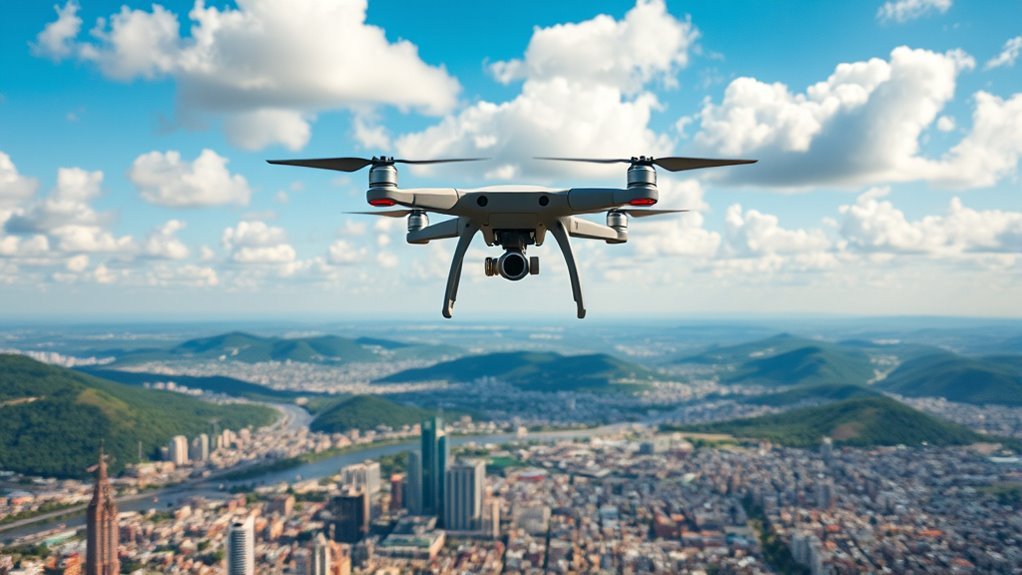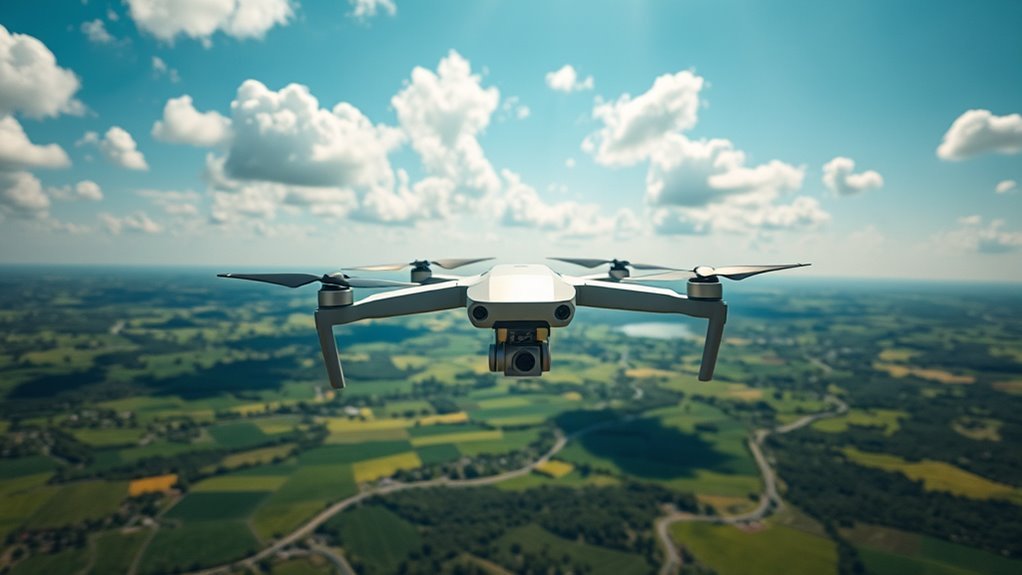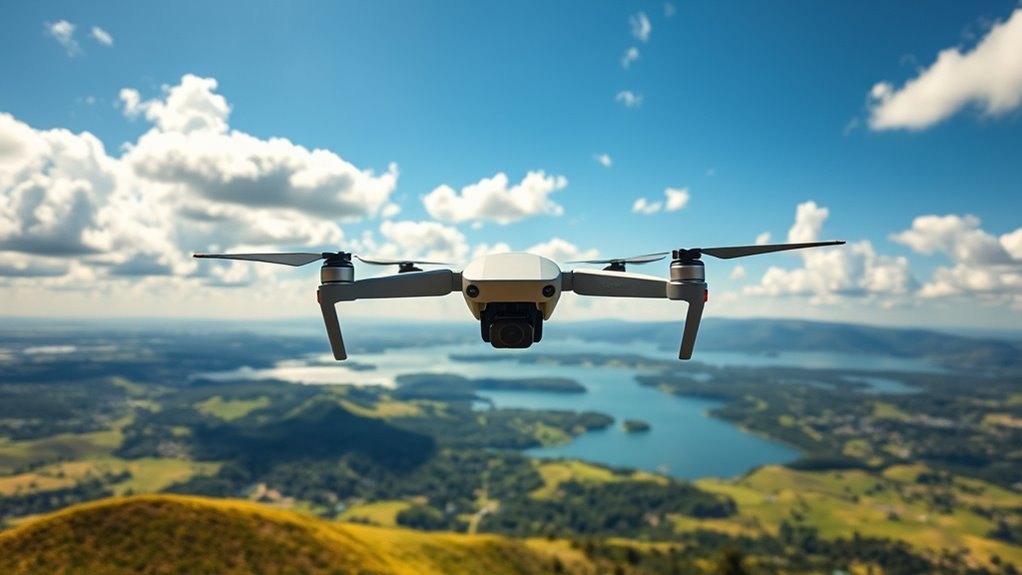You can legally fly a drone up to a maximum altitude of 400 feet above ground level in the U.S. This limit applies to recreational users, while commercial operators may have different height restrictions based on the nature of their tasks. It’s essential to monitor your altitude and be aware of local regulations, as they may impose additional limits. Staying compliant guarantees safe operation, and there are more important details you should consider for responsible drone flying.
Understanding Drone Regulations

When it comes to flying a drone, understanding the regulations is essential for safe and legal operation. You need to prioritize drone safety to guarantee not just your freedom, but also the safety of others. One significant aspect is altitude awareness; knowing how high you can legally fly a drone helps prevent conflicts with manned aircraft and maintains compliance with local laws. Generally, you should keep your drone below 400 feet in uncontrolled airspace. Additionally, understanding airspace classifications will assist in identifying operational areas and any associated restrictions. Being aware of surrounding airspace restrictions and temporary flight restrictions will enhance your flying experience while minimizing risks. Ultimately, staying informed about regulations lets you enjoy the freedom of flying while operating within the bounds of safety and legality. Additionally, compliance with drone registration is crucial to avoid legal repercussions.
Federal Aviation Administration (FAA) Guidelines

Although many drone enthusiasts may be keen to explore the skies, it’s crucial to adhere to the Federal Aviation Administration (FAA) guidelines to guarantee safe operations. First, you need to comply with drone registration requirements; any drone weighing more than 0.55 pounds must be registered before flight. Understanding airspace classifications is equally important, and flight performance can significantly affect your drone’s operation within these classifications. The FAA categorizes airspace into various classes, each with specific rules and restrictions. For instance, flying in controlled airspace requires permission, while you can fly in uncontrolled airspace with fewer restrictions. Always check local regulations, as they may impose additional requirements. Additionally, be aware of no-fly zones to avoid penalties and ensure safe drone operation. By following these guidelines, you can enjoy the freedom of flying your drone while ensuring safety for yourself and others in the airspace.
Maximum Altitude Limits for Recreational Use

The maximum altitude limit for recreational drone use in the United States is set at 400 feet above ground level. This height restriction is vital for maintaining safety and avoiding interference with manned aircraft. When flying your drone, it’s important to monitor your drone altitude carefully, as exceeding this limit can lead to penalties and jeopardize airspace safety. You’re encouraged to utilize altitude reporting features available in many drones to guarantee compliance. Additionally, always be aware of your surroundings, as local laws may impose further height restrictions depending on the area. Staying informed and adhering to these regulations allows you to enjoy the freedom of flying while respecting safety guidelines that protect everyone in the airspace.
Commercial Drone Flight Altitude Restrictions
While recreational drone pilots must adhere to a 400-foot altitude limit, commercial drone operators face a different set of regulations that can vary based on the specifics of their operations. Depending on your commercial drone licensing, you may be permitted to fly at higher altitudes, especially for specific tasks such as surveying or infrastructure inspection. Utilizing altitude measurement tools is essential to guarantee compliance with FAA regulations.
| Operation Type | Maximum Altitude |
|---|---|
| Aerial Photography | 400 feet |
| Infrastructure Inspection | Up to 1,200 feet |
| Agricultural Monitoring | 600 feet |
| Surveying | 1,500 feet |
| Emergency Services | Case-by-case basis |
Understanding these restrictions will empower you to navigate the skies legally and effectively.
Special Considerations for Urban Areas
When flying drones in urban areas, you need to contemplate a range of unique challenges and regulatory requirements. Urban drone challenges include maneuvering tightly packed buildings, which can obstruct GPS signals and complicate flight paths. You’ll also face potential restrictions from local laws that vary by city, so it’s essential to research these before launching. Additionally, noise pollution is a significant concern; drones generate sounds that can disturb residents and wildlife, prompting stricter regulations. To maximize your freedom while minimizing disruptions, maintain a low profile by flying at lower altitudes and avoiding high-traffic areas. Being aware of these factors will help guarantee a smoother, more compliant flying experience in urban environments. Implementing effective alert systems can also enhance your situational awareness and help you respond to potential privacy threats.
Consequences of Exceeding Legal Altitudes
Exceeding legal altitudes when flying a drone can lead to serious repercussions that go beyond mere fines. You may face significant legal penalties that can impact your ability to operate drones in the future. Here are some potential consequences:
- Fines: Monetary penalties can vary depending on the severity of the violation.
- License Suspension: Your drone operator certification might be suspended or revoked.
- Legal Action: You could face lawsuits from individuals or entities affected by your safety violations.
- Increased Scrutiny: Authorities may monitor your future flights more closely.
- Insurance Issues: Violations can lead to increased premiums or denial of coverage.
Understanding and adhering to altitude regulations is essential for maintaining safety and protecting your freedom as a drone operator.
Tips for Compliant Drone Operation
To guarantee compliant drone operation, you need to know your local regulations regarding altitude limits and restricted airspace. It’s also essential to maintain visual line-of-sight with your drone at all times during flight. Adhering to these guidelines will help you avoid legal issues and guarantee safe operations.
Know Your Local Regulations
Although flying a drone can be an exhilarating experience, it’s crucial to understand and comply with local regulations to guarantee safe operation. Familiarizing yourself with these rules can help you avoid fines and promote responsible use of your drone. Here are some key points to keep in mind:
- Check for local restrictions on airspace and flight zones.
- Obtain necessary drone permits specific to your area.
- Stay updated on changes in legislation that may affect drone use.
- Respect privacy laws to avoid potential legal issues.
- Register your drone with appropriate authorities if required.
Maintain Visual Line-of-Sight
Understanding local regulations is just the first step in responsible drone operation; maintaining visual line-of-sight is equally important. You need to guarantee you can visually track your drone at all times during flight. This practice enhances flight awareness, allowing you to react promptly to obstacles, other aircraft, or changes in airspace conditions. To achieve this, keep your drone within a distance that allows you to maintain clear visibility, typically within 500 feet horizontally and 400 feet vertically. Using visual aids like binoculars can help, but they shouldn’t replace direct visual contact. Remember, flying beyond visual line-of-sight can lead to safety hazards and legal repercussions, compromising your freedom to fly responsibly. Stay aware and fly smart!
Frequently Asked Questions
Can I Fly Drones at Night Legally?
Yes, you can fly drones at night legally, but you must adhere to night flying regulations, including specific drone lighting requirements. Guarantee your drone is equipped with appropriate lights to maintain visibility and comply with safety standards.
Do I Need a License for Recreational Drone Flying?
So, you think flying a drone’s like a free-for-all? Well, not quite! You don’t need a license for recreational flying, but follow drone regulations and recreational guidelines to keep your airborne escapades legal and fun.
Are There Height Restrictions Near Airports?
When flying near airports, you’ve got to adhere to strict airport drone regulations. Altitude safety guidelines often limit your height to 400 feet, ensuring safety for both your drone and nearby aircraft. Always check local rules.
What Happens if I Fly Over People?
If you fly over people, you risk legal consequences and jeopardize drone safety. Authorities might impose fines or penalties, especially if your actions cause harm or violate regulations. Always prioritize safety to maintain freedom in drone operation.
Can I Fly My Drone Beyond Visual Line of Sight?
You can’t legally fly your drone beyond visual line of sight without a special waiver. It’s essential to understand regulations; staying within sight guarantees safety and compliance, allowing you to enjoy aerial freedom responsibly.

